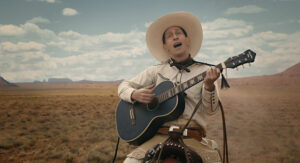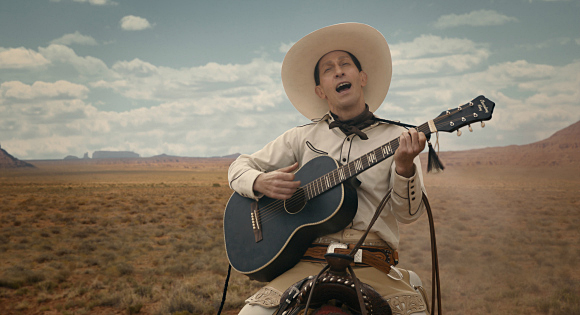Movie Info
Movie Notes
I am playing catch-up with this film and with The Queen’s Gambit this month.
Movie Info
- Director
- Ethan & Joel Coen
- Run Time
- 2 hours and 13 minutes
- Rating
- R
VP Content Ratings
- Violence
- 5/10
- Language
- 2/10
- Sex & Nudity
- 1/10
- Star Rating
Relevant Quotes
Vanity of vanities, says the Teacher,
vanity of vanities! All is vanity.
What do people gain from all the toil
at which they toil under the sun?
And he called them to him, and spoke to them in parables…

After writing about so many heavy films dealing with racism and such, I wanted a change, and the Coen brothers certainly provided this in the six-segment film set in the Old West. None of the six stories are connected, other than by the time and their transpiring west of the Mississippi. They range from the whimsical to the somber, with all infused with the wittiness expected from a Coen film. The script is by them, with two of the stories based on or “inspired by” other authors—“All God Canyon” by a Jack London story, and “The Gal Who Got Rattled” by Stewart Edward White.
The segments are framed by a time-honored Hollywood device: an old book with the title embossed on the cloth cover is opened to the title page of the story and then an illustration with a caption. With each story beginning thusly, we get the feeling that we are sitting with an old fashioned story book filled with stalwart characters and thrilling deeds.
- “The Ballad of Buster Scruggs” is typical Coens, with Tim Blake Nelson as Buster Scruggs, a singing cowboy clad in white whom we first see moseying along playing his guitar and singing “Cool Clear Water.” (This being a Coen Brothers’ work, I almost expected Buster to smirk and say to us, “Bet yer wondering how I can sing a song not written unto 40 or 50 years from now!”) Our singer is a notorious gunslinger, as we soon see when insulted in a saloon and then challenged to the street duel once the standard cliché for Westerns. Although there are no qualms about gunning down the room full of thugs in the saloon, Buster tries not to kill his challenger, just shooting off the man’s trigger finger, and when the guy persists, all the rest on his right hand. When the fool switches to his left hand, Buster comments that “the quit” was never put into the man, and so he takes out a mirror and calculates just how to aim when the image reverses its object. Soon another challenger appears, but this time Buster miscalculates. His final words, pure Coen Brothers, and the song he sings as his spirit leaves his body, “When A Cowboy Trades His Spurs For Wings,” will leave you laughing rather than mourning.
- In “Near Aldgones” a would-be bank robber (James Franco) underestimates the mild-looking teller (Stephen Root) at a bank isolated in the desert yet with an interior as swank as anything back in New York City. Using a washboard and pots and pans as body armor, the teller pursues the robber and knocks him out. He survives hanging by the posse by rampaging Indians who show up, killing all the would-be hangers. He still is liable to hang because they leave him tied up on his horse underneath the tree to which the hangman’s rope is tied. The horse is about to step forward to nibble the grass just ahead. A drover unties him, so he joins him in his cattle driver. Not a good decision. The man has rustled the herd. A posse arrives, but the drover escapes. Captured again, he is made to stand on the gallows alongside other condemned. One man is moaning and crying, and Franco’s characters asks if this is his first time.
- “Meal Ticket” is the story of a traveling impresario (Liam Neeson) whose wagon is cleverly turned into a stage. Each night his partner, the paraplegic actor Harrison (Harry Melling), recites poetry and lines from plays. Shelley’s “Ozymandias” is at the beginning, Shakespeare and others in the middle, and the climactic ending is always the Gettysburg Address. The impresario serves as wagon driver, poster putter-upper, emcee, and dresser and feeder of the actor. The poster calls the actor “The Wingless Thrush.” We see no trace of any friendship, of any bonding between the two. As the audience dwindles, the impresario apparently decides to change acts, the replacement being a flock of chickens taught to count. In the town where they compete the chickens outdrew the actor’s audience by a hundred to one. The impresario buys the chickens. What he does with the actor makes this segment of Buster Scruggs the drollest of the six.
- “All Gold Canyon” has perhaps the most beautiful scenery of the six stories, with an elderly prospector and his donkey coming upon a paradise-like mountain valley. The silence of the golden valley is broken by his talking to himself and his patient pack animal. Beside a stream he determines by trial and error where a lode of gold is likely. After long and arduous digging he comes upon the treasure trove, but almost loses it when a thief who has ben following him tries to kill him.
- “The Gal Who Got Rattled” is the most sardonic and poignant of the stories, an engaging take on the old wagon train sub genre—also at 40 minutes, the longest of the segments. A soulful woman Alice Longabaugh (Zoe Kazan) and her brother Gilbert are on their way to Oregon where her ne-er do well sibling has a business venture that might include her marrying his partner. However, brother dies of cholera, leaving the hapless girl alone. Associate wagon master Billy Knapp (Bill Heck) takes at first a charitable interest in helping her, this during the next few days morphing into a romantic one. His partner Mr. Arthur is a bit jealous and not pleased at losing his partner. However, the next day when he goes in search of the wandered off Alice, an attack by Comanches upends everything. (How can we have a Western without Indians, or “Injuns” as the older, unreformed Westerns called Native Americans. As in most pre-Sixties films of the genre, they are but props that bring fear and death.) Preparing for the attack, he gives her his pistol and instructs her what she must do in the event that he cannot stave off the Indian attack. Because its longer running time has bought more
- “The Mortal Remains,” perhaps seen by some as a tip of the hat to John Ford’s Stagecoach, though set at the beginning of sundown, focuses upon five passengers and their banter about human existence and death. Two of them are bounty hunters, the corpse of their quarry, to which the subtitle refers, is wrapped in a cloth and tied to the roof of the coach. Like a ship of fools, the coach full of people who reach the point of barely being able to stand each other finally arrives at their destination, a hotel in the middle of nowhere, the whole episode apparently a metaphor the meaning of which extends beyond the details of their journey and arrival. This concluding episode leaves us with plenty to think about.
I see that some critics have regarded this film as “minor Coen Brothers,” and maybe it is, compared to some of their other numerous works. But even a “minor” Coen Brothers film is preferable to so many of the mediocre films by less talented directors. The stories are not connected by any of the characters, but they are by the theme of death and folly. It is as if the jaded writer of Ecclesiastes had been equipped with a film camera, rather than by quill and papyrus. The teller(s), the two brothers, also have seen it all, and the
Old West enshrined in so many mythological films of gunslingers, prospectors, wagoneers setting out to begin anew and blood-thirsty “savages” out to stop them—all of their journeys will end in the grave. Not a very comforting picture, but one we need to consider, we who live in a death-denying culture that thinks science and technology are our salvation.
This review will be in the May issue of VP along with a set of questions for reflection and/or discussion. If you have found reviews on this site helpful, please consider purchasing a subscription or individual issue in The Store.

